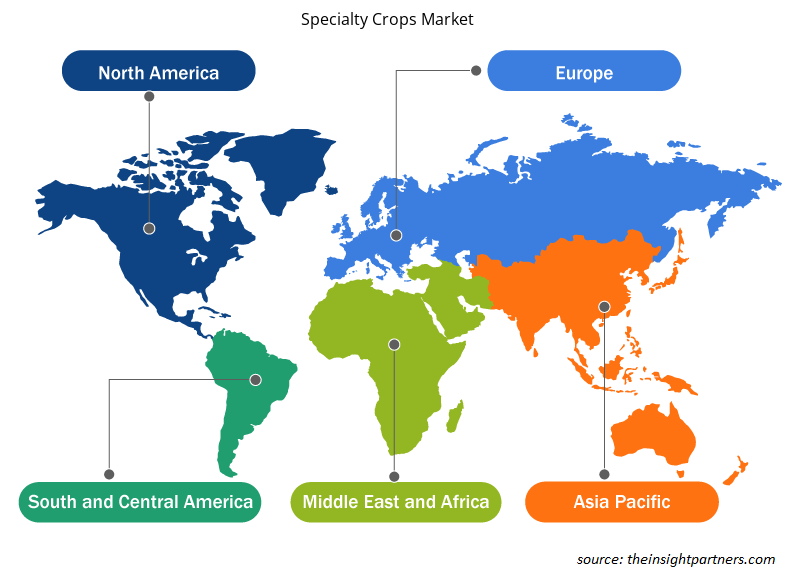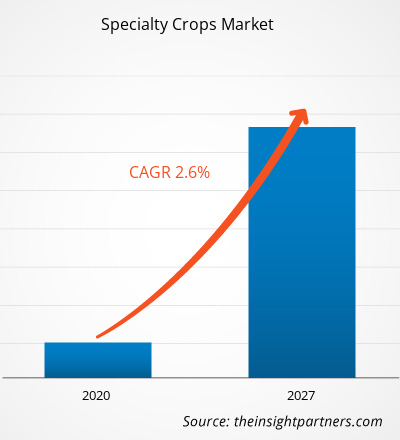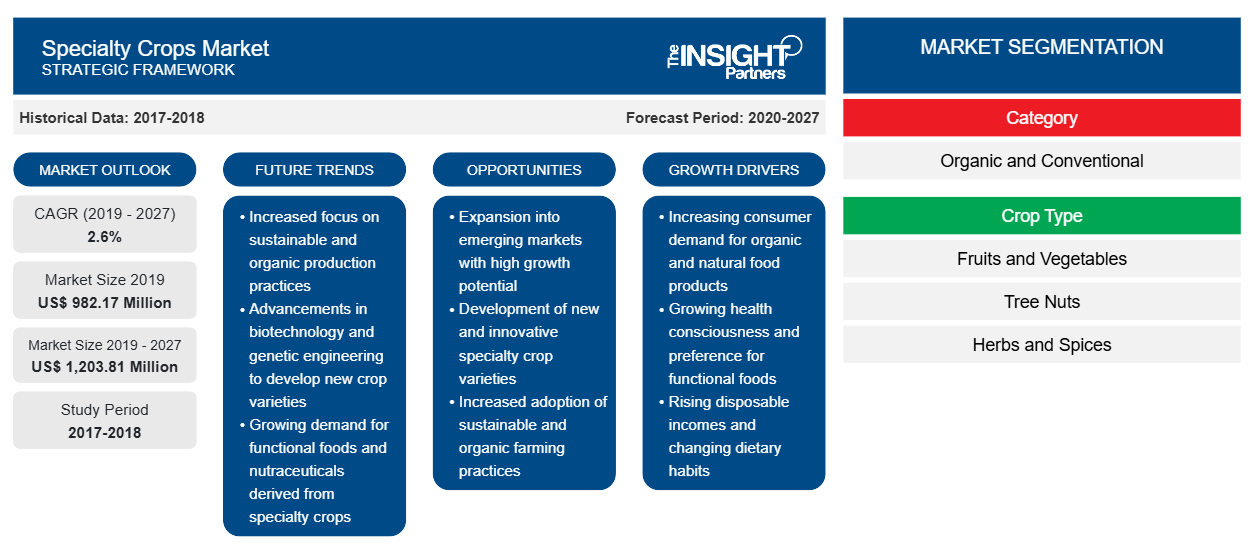2019 年特种作物市场价值为 9.8217 亿美元,预计到 2027 年将达到 12.0381 亿美元;预计 2020 年至 2027 年的复合年增长率为 2.6%。
特种作物是指水果和蔬菜、坚果、干果、园艺作物和苗圃作物(包括花卉栽培)。它们还包括由于气候和地形特征而专门在一个地区种植的外来作物。随着人口的增长,加上人均可支配收入的增加,消费者饮食模式发生了范式转变,这直接影响了对健康和美味食品的需求。此外,快速的城市化、种族构成、健康问题和人口特征的变化也是促进特种作物需求的其他因素。特种作物应用范围的扩大、政府的支持措施和自由贸易政策是推动特种作物市场的关键因素。然而,环境和贸易壁垒限制了特种作物市场的增长。
2019 年,亚太地区占据了全球特种作物市场的最大份额。该地区由几个新兴国家组成,由于民众可支配收入的增加,消费者的生活方式正在迅速改变。此外,西方生活方式和快速城市化的影响正在推动该地区方便食品的增长。该地区的消费者对植物性食品非常感兴趣,这进一步推动了特种作物市场的增长。为了获得最佳市场份额,该地区的公司正在实施各种技术。例如,中国公司正在使用加速成熟储存来满足市场需求。加速成熟可保证与自然成熟的水果相同的颜色、气味和味道。许多参与者已经开始认识到加速成熟的必要性和重要性,并建立了加速成熟仓库。
COVID-19 于 2019 年 12 月首先在中国武汉爆发,此后已蔓延至全球。截至 2021 年 2 月,美国、印度、巴西、俄罗斯、英国、法国、西班牙、意大利、土耳其、德国、哥伦比亚和阿根廷是确诊病例和报告死亡人数最多的国家。根据世界卫生组织的最新数据,全球确诊病例约 102,584,351 例,死亡人数约 2,222,647 例。由于封锁、旅行禁令和企业停业,冠状病毒疫情已影响到各国的经济和行业。农业行业是受此次疫情影响严重中断的主要行业之一,例如供应链中断、技术活动取消和办公室关闭。北美、欧洲、亚太地区、南美以及中东和非洲的多家工厂关闭,影响了全球供应链,并对各种商品的制造、交付计划和销售产生了负面影响。
过去十年,特种作物市场一直在持续增长。然而,COVID-19 疫情的爆发给该行业带来了独特的挑战,威胁到其持续增长。因此,各国政府正在为特种作物种植者提供支持,以重获市场势头。例如,作为冠状病毒农业援助计划的一部分,美国农业部 (USDA) 正在向农产品价格下跌 5% 或以上或因 COVID-19 导致市场供应链中断而遭受损失的农产品生产商提供重要的财政支持。因此,政府的此类有利举措预计将帮助特种作物市场参与者。
定制此报告以满足您的需求
您可以免费定制任何报告,包括本报告的部分内容、国家级分析、Excel 数据包,以及为初创企业和大学提供优惠和折扣
- 获取此报告的关键市场趋势。这个免费样品将包括数据分析,从市场趋势到估计和预测。
市场洞察
政府支持措施和自由贸易政策
政府采取的积极举措大力支持特种作物的发展,包括销售和营销活动、植物病虫害防治以及研发。例如,2018 年通过的农业法案(2018 年农业改进法案)旨在重新授权和扩大现有计划,以促进多种特种作物(如水果和蔬菜、坚果和苗圃产品)的生长。该农业法案的实施旨在通过特种作物专项补助计划和特种作物市场新闻为特种作物生产商提供支持。通过这些计划,美国农业部致力于提高竞争力,并在营销、病虫害管理、研究和食品安全方面提供支持。该法案还承认了围绕特种作物的几个贸易问题,并提供技术和出口援助。除此之外,还成立了一个研究机构——特种作物研究计划 (SCRI),旨在鼓励合作、开放沟通和信息交流。此外,政府还提供粮食援助计划,以振兴受 COVID-19 疫情影响的特种作物生产商。提供这项援助是为了促进特色作物的生长,包括园艺、坚果、水果和蔬菜以及靛蓝。美国农业部正在加强冠状病毒粮食援助计划 2,以帮助遭受市场混乱和价格波动的生产商。此外,在印度,政府已决定向温室或大棚提供 50% 的补贴,以促进苗圃作物的生长。除了政府计划外,还实施了自由贸易政策,这些政策大大整合了供应链流程,从而提高了贸易活动效率,增加了贸易量,并增加了获得质量更好、价格更低的商品的机会。
类别洞察
根据类别,全球特种作物市场分为有机和传统两大类。2019 年,传统作物引领了全球特种作物市场。传统耕作是最常用的耕作方法之一,涉及使用合成肥料、农药和其他化学化合物。小农和边际农户广泛采用传统耕作技术,以较低的生产成本获得更高的产量。该技术有利于生产者和种植者,因为与成本相比,产量较高。此外,农民对有机农业带来的健康和环境效益缺乏了解,这促进了该领域的增长。然而,这种方法有几个缺点。使用传统方法种植的作物由于使用合成农用化学品而含有化学残留物,可能对动物和人类有害。
作物类型洞察
就作物类型而言,全球特种作物市场分为水果和蔬菜、坚果、香草和香料等。2019 年,水果和蔬菜占据了全球特种作物市场的主导地位。水果和蔬菜是农业生产的重要组成部分,它们全年广泛种植,用于商业和家庭用途。由于水果和蔬菜营养丰富,全球对它们的需求很高。除了直接的国内消费外,这些作物还可用于多种终端行业。美国农业部已将不同水果定义并归类为特种作物,包括苹果、鳄梨、香蕉、黑莓、蓝莓、面包果、可可、番荔枝、樱桃、黑果乔基里、柑橘、椰子、咖啡、蔓越莓、醋栗、枣、费约果、无花果、醋栗、葡萄(包括葡萄干)、番石榴、猕猴桃、荔枝、澳洲坚果、芒果、油桃和橄榄。它还将不同的蔬菜归类为特色作物,包括洋蓟、芦笋、甜菜、西兰花、胡萝卜、花椰菜、芹菜、芹菜、鹰嘴豆、细香葱、羽衣甘蓝、黄瓜、毛豆、茄子、菊苣、豌豆(花园、干、食用)、大蒜、辣根、大头菜、韭菜、小扁豆和生菜。由于消费者对有机农产品健康益处的认识不断提高,对有机种植的特色水果和蔬菜的需求也在增加。此外,快速的城市化和消费者对健康生活方式的偏好转变也鼓励人们在饮食中加入水果和蔬菜,从而促进了该细分市场的增长。
并购和研发是企业扩大全球业务范围的常用策略,这进一步影响了市场规模。特种作物市场的参与者正在实施并购和研发战略,以扩大客户群并在全球范围内获得显著的市场份额,这也使参与者能够在全球范围内保持其品牌名称。
特色作物市场区域洞察
Insight Partners 的分析师已详细解释了预测期内影响特种作物市场的区域趋势和因素。本节还讨论了北美、欧洲、亚太地区、中东和非洲以及南美和中美洲的特种作物市场细分和地理位置。

- 获取特色作物市场的区域特定数据
特色作物市场报告范围
| 报告属性 | 细节 |
|---|---|
| 2019 年市场规模 | 9.8217亿美元 |
| 2027 年市场规模 | 12.0381亿美元 |
| 全球复合年增长率(2019 - 2027) | 2.6% |
| 史料 | 2017-2018 |
| 预测期 | 2020-2027 |
| 涵盖的领域 | 按类别
|
| 覆盖地区和国家 | 北美
|
| 市场领导者和主要公司简介 |
|
特色作物市场参与者密度:了解其对业务动态的影响
特种作物市场正在快速增长,这得益于终端用户需求的不断增长,而这些需求又源于消费者偏好的不断变化、技术进步以及对产品优势的认识不断提高等因素。随着需求的增加,企业正在扩大其产品范围,进行创新以满足消费者的需求,并利用新兴趋势,从而进一步推动市场增长。
市场参与者密度是指在特定市场或行业内运营的企业或公司的分布情况。它表明在给定市场空间中,相对于其规模或总市场价值,有多少竞争对手(市场参与者)存在。
在特色作物市场运营的主要公司有:
- 钻石水果公司
- 海港香料有限公司
- 奥兰国际
- 俄勒冈香料公司
- 特种作物公司。
免责声明:上面列出的公司没有按照任何特定顺序排列。

- 获取特色作物市场顶级关键参与者概述
报告亮点
- 全球特色作物市场不断发展的行业趋势,帮助参与者制定有效的长期战略
- 发达市场和发展中市场采用的业务增长战略
- 2017 年至 2027 年全球特色作物市场定量分析
- 各行业对全球特色作物需求的估计
- PEST 分析说明行业内买家和供应商预测市场增长的有效性
- 了解竞争激烈的市场形势和全球特色作物需求的最新发展
- 市场趋势和前景,以及推动和抑制全球特色作物市场增长的因素
- 通过了解支撑全球特色作物市场增长商业利益的战略来进行决策
- 全球特色作物市场规模在各个市场节点
- 全球特色作物市场的详细概述和细分,以及该行业的动态
- 全球各地区特色作物市场规模及增长机遇
全球特色作物市场 – 按类别划分
- 有机的
- 传统的
全球特色作物市场 – 按作物类型划分
- 水果和蔬菜
- 树坚果
- 香草和香料
- 其他的
公司简介
- 钻石水果公司
- 海港香料有限公司
- 奥兰国际
- 俄勒冈香料公司
- 特种作物公司
- 巴纳湾有限公司
- 米果公司
- 费希尔坚果公司
- Simped 食品有限公司
- SVZ 工业水果蔬菜配料
- 历史分析(2 年)、基准年、预测(7 年)及复合年增长率
- PEST和SWOT分析
- 市场规模、价值/数量 - 全球、区域、国家
- 行业和竞争格局
- Excel 数据集
近期报告
客户评价
购买理由
- 明智的决策
- 了解市场动态
- 竞争分析
- 客户洞察
- 市场预测
- 风险规避
- 战略规划
- 投资论证
- 识别新兴市场
- 优化营销策略
- 提升运营效率
- 顺应监管趋势





















 获取免费样品 - 特色作物市场
获取免费样品 - 特色作物市场